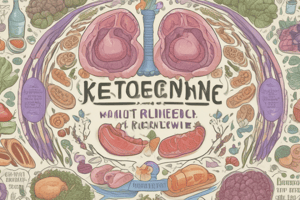Podcast
Questions and Answers
What is the most prevalent of serious neurological disorders?
What is the most prevalent of serious neurological disorders?
Epilepsy
What is the cause of seizure activity?
What is the cause of seizure activity?
Abnormal and excessive discharge from the neurons in the brain
Epilepsy is the most prevalent of the serious neurological disorders.
Epilepsy is the most prevalent of the serious neurological disorders.
True (A)
Which of the following types of diets is most likely to be used to treat epilepsy?
Which of the following types of diets is most likely to be used to treat epilepsy?
What is the primary purpose of the ketogenic diet?
What is the primary purpose of the ketogenic diet?
The ketogenic diet is a low-fat diet.
The ketogenic diet is a low-fat diet.
When was the ketogenic diet initially used to treat epilepsy?
When was the ketogenic diet initially used to treat epilepsy?
The ketogenic diet is now exclusively used for those with drug-resistant epilepsy.
The ketogenic diet is now exclusively used for those with drug-resistant epilepsy.
How does the ketogenic diet help reduce seizure frequency?
How does the ketogenic diet help reduce seizure frequency?
Why does the ketogenic diet induce the formation of ketone bodies?
Why does the ketogenic diet induce the formation of ketone bodies?
What are two key ketone bodies produced by the ketogenic diet?
What are two key ketone bodies produced by the ketogenic diet?
The ketogenic diet increases glucose supply to the brain.
The ketogenic diet increases glucose supply to the brain.
What is the main transporter of ketone bodies into the brain?
What is the main transporter of ketone bodies into the brain?
The ketogenic diet can be considered an alternative energy source for the brain.
The ketogenic diet can be considered an alternative energy source for the brain.
Ketones possibly exert an anticonvulsive effect.
Ketones possibly exert an anticonvulsive effect.
What is the most common type of ketogenic diet?
What is the most common type of ketogenic diet?
What is the basis of the classical ketogenic diet?
What is the basis of the classical ketogenic diet?
What is typically the fat component of the classical ketogenic diet?
What is typically the fat component of the classical ketogenic diet?
The classical ketogenic diet relies on a very low protein intake.
The classical ketogenic diet relies on a very low protein intake.
What is the carbohydrate restriction like in the classical ketogenic diet?
What is the carbohydrate restriction like in the classical ketogenic diet?
What is a common example ratio for the classical ketogenic diet?
What is a common example ratio for the classical ketogenic diet?
What is the primary advantage of the MCT diet?
What is the primary advantage of the MCT diet?
MCTs are absorbed less efficiently than LCTs.
MCTs are absorbed less efficiently than LCTs.
The MCT diet allows for a lower total fat intake than the classical diet.
The MCT diet allows for a lower total fat intake than the classical diet.
Which ketogenic diet type is considered appropriate for older children and adolescents who may have difficulty adhering to the strict restrictions of the classical or MCT diets?
Which ketogenic diet type is considered appropriate for older children and adolescents who may have difficulty adhering to the strict restrictions of the classical or MCT diets?
The Modified Atkins Diet allows for a free intake of protein.
The Modified Atkins Diet allows for a free intake of protein.
The Modified Atkins Diet is very high in carbohydrates.
The Modified Atkins Diet is very high in carbohydrates.
Which of the following is a characteristic of the Low Glycemic Index Treatment (LGIT)?
Which of the following is a characteristic of the Low Glycemic Index Treatment (LGIT)?
The LGIT is a high-protein and high-carbohydrate diet?
The LGIT is a high-protein and high-carbohydrate diet?
The LGIT allows for a higher carbohydrate intake than the classical ketogenic diet.
The LGIT allows for a higher carbohydrate intake than the classical ketogenic diet.
Which of the following is a potential side effect of the ketogenic diet?
Which of the following is a potential side effect of the ketogenic diet?
The ketogenic diet is known to help with weight gain in children.
The ketogenic diet is known to help with weight gain in children.
What is a potential complication of the ketogenic diet that involves the heart?
What is a potential complication of the ketogenic diet that involves the heart?
What is a primary consideration before commencing the ketogenic diet?
What is a primary consideration before commencing the ketogenic diet?
Children with feeding difficulties are good candidates for the ketogenic diet.
Children with feeding difficulties are good candidates for the ketogenic diet.
The ketogenic diet is generally recommended for children with food allergies.
The ketogenic diet is generally recommended for children with food allergies.
The ketogenic diet is well-suited for children with gastroesophageal reflux.
The ketogenic diet is well-suited for children with gastroesophageal reflux.
The ketogenic diet is a long-term commitment.
The ketogenic diet is a long-term commitment.
Families are expected to play an active role in managing the ketogenic diet.
Families are expected to play an active role in managing the ketogenic diet.
What is a key component of family involvement in managing the ketogenic diet?
What is a key component of family involvement in managing the ketogenic diet?
Families on the ketogenic diet should avoid regular clinic appointments.
Families on the ketogenic diet should avoid regular clinic appointments.
What is the primary purpose of a 3-4 day food diary?
What is the primary purpose of a 3-4 day food diary?
Which of the following is NOT a factor to consider in the dietetic assessment for the ketogenic diet?
Which of the following is NOT a factor to consider in the dietetic assessment for the ketogenic diet?
The ketogenic diet is universally recommended for all children with epilepsy.
The ketogenic diet is universally recommended for all children with epilepsy.
The classical ketogenic diet is the most commonly used and has a long history of being used in the USA.
The classical ketogenic diet is the most commonly used and has a long history of being used in the USA.
The MCT diet is always the best option for children with epilepsy.
The MCT diet is always the best option for children with epilepsy.
The classical ketogenic diet is ideal for children with a high level of carbohydrate tolerance.
The classical ketogenic diet is ideal for children with a high level of carbohydrate tolerance.
The Modified Atkins Diet is only recommended for adolescents.
The Modified Atkins Diet is only recommended for adolescents.
Flashcards
Ketogenic Diet for Epilepsy
Ketogenic Diet for Epilepsy
High-fat, restricted-carbohydrate diet used to treat epilepsy, especially in cases unresponsive to medication. It induces ketone bodies as an anticonvulsant.
Ketogenic Diet Types
Ketogenic Diet Types
Classical, MCT, Modified Atkins, and Low Glycemic Index (LGIT) – each varying in fat, carbohydrate, and protein ratios for different needs and tolerance levels.
Classical Ketogenic Diet
Classical Ketogenic Diet
High fat, very low carbohydrate, and sufficient protein ratio diet. Often uses long-chain triglycerides (LCT) and has a strict ratio.
MCT Ketogenic Diet
MCT Ketogenic Diet
Signup and view all the flashcards
Modified Atkins Ketogenic Diet
Modified Atkins Ketogenic Diet
Signup and view all the flashcards
Low Glycemic Index Treatment (LGIT)
Low Glycemic Index Treatment (LGIT)
Signup and view all the flashcards
Possible Side Effects
Possible Side Effects
Signup and view all the flashcards
Diet Initiation Considerations
Diet Initiation Considerations
Signup and view all the flashcards
Family Commitment
Family Commitment
Signup and view all the flashcards
Dietetic Assessment
Dietetic Assessment
Signup and view all the flashcards
Diet Duration
Diet Duration
Signup and view all the flashcards
Calculating the Diet
Calculating the Diet
Signup and view all the flashcards
Ketosis
Ketosis
Signup and view all the flashcards
Study Notes
Ketogenic Diets
- Epilepsy is the most prevalent neurological disorder, with highest incidence in early childhood and old age.
- Seizures are caused by abnormal and excessive neuron discharge in the brain.
- Anti-epileptic medication controls seizures in most cases, but a minority don't respond.
- Ketogenic diets, high in fat and restricted in carbohydrates, were used to treat epilepsy before anti-epileptic medication became available (1920).
- Ketogenic diets are now reserved for those resistant to drug therapy.
How Ketogenic Diets Work
- One theory suggests fasting decreases seizure frequency by inducing ketone body formation (acetoacetate and β-hydroxybutyrate).
- This occurs due to the absence of adequate glucose supply creating an anticonvulsant effect.
Types of Ketogenic Diets
- Classical ketogenic diet: ratio of fat to carbohydrate and protein (e.g., 4:1).
- Fat component is long-chain triglycerides (LCT), recently using medium-chain triglycerides (MCT).
- Protein is based on minimum growth requirements.
- Carbohydrate is very restricted.
- MCT ketogenic diet: yields more ketones per kilocalorie of energy.
- MCTs are absorbed more efficiently and delivered directly to the liver.
- This allows for more carbohydrate and protein inclusion in the diet.
- Modified ketogenic diet (Modified Atkins):
- Free protein intake.
- Very low carbohydrate and high fat. (approximately 75% of total calories).
- Low glycemic index treatment (LGIT)
- Designed to limit post-prandial blood glucose (BG) levels by restricting carbohydrate to 10% of total calories and using only low glycemic index carbohydrates.
- Fat: 60% of calories
- Protein: 30% of calories
- Designed to limit post-prandial blood glucose (BG) levels by restricting carbohydrate to 10% of total calories and using only low glycemic index carbohydrates.
Possible Side Effects
- Raised lipid levels (less in MCT, no risk of CVD later).
- Delayed growth (especially during first 6 months).
- Cardiac complications (possible Se deficiency)
- Pancreatitis
- Hypoproteinemia
- Hematological issues (impaired neutrophil and platelet function)
Considerations Before Starting
- Epilepsy diagnosis by a pediatric neurologist.
- Identify other contraindications (feeding difficulties, dysphagia, GERD, etc.)
- Evaluate dietary restrictions and allergies, and medical history.
Family Commitment
- Monitor and record weight, urine and blood ketones.
- Keep a seizure diary.
- Communicate frequently with dietitian.
- Attend regular clinic appointments.
- Lab tests and urinalysis.
Dietetic Assessment
- 3-4 day food diary to assess diet suitability, child preferences, and eating patterns.
- Consider nutritional factors, allergies, swallowing problems, food textures, anthropometric tests (W, H, HC), mobility, vitamin and mineral supplementation, bowel habits, caregivers, seizure type and frequency, medications.
Deciding Which Ketogenic Diet to Use
- Advantages and disadvantages of each type (Classical, MCT, Modified KD, LGIT).
- Factors to consider specific to each diet style.
Duration of Dietary Treatment
- 3-month trial period.
- Discontinue if not effective or if side effects outweigh benefits.
- Review every 6 months.
- Trial off diet at 2 years.
Initiating the Ketogenic Diet
- Prescription adjusted over time based on weight, ketosis levels, seizure control and activity.
- Fasting not always necessary.
- Calorie requirements based on the Estimated Average Requirement (EAR).
- Protein requirements based on growth (1-1.2 g/kg/d).
Diet Prescription for the Classical Diet
- Calculation based on calorie and protein requirements, and ratio of fat to (protein+CHO).
- Examples of ratios (4:1, 3.5:1, 3:1, etc) and respective fat percentages.
Meal Replacements
- For unwell children needing meal replacement, Ketocal LQ (4:1 ratio) can be used, maintaining the same ratio as the child's usual prescription.
Initiating the Classical Diet
- Start with a 2:1 ratio and gradually increase to 3:1 or 4:1.
Managing the Ketogenic Diet
- Adequate fluid intake essential to reduce renal stone risk.
- Vitamins and mineral supplements (full vitamin and minerals, sup free of CHO).
Other Supplements
- K citrate to alkalize urine and reduce the risk of kidney stones.
- Carnitine supplementation for high fat intake, especially in deficiency states.
- Minimizing CHO content of medications.
Adding Interest to the Diet
- MCT oil can be used in cooking.
- Liquigen can be used in making desserts or snacks.
- Butter, margarine, oil, cream and mayonnaise.
Free Foods
- Water, low CHO squash, diet fizzy drinks, CHO-free sweeteners (without maltodextrin), spices.
Monitoring the Diet
- Monitor blood and urine ketones.
- Maintain a seizure diary.
- Aim for moderate to high urine ketones to be in the range of 4 to 16 mmol/L.
- Finger prick blood ketone measurement is helpful.
3 Monthly Monitoring
- Measure weight, height and mid-arm circumference.
- Measure head circumference in younger children.
- Screen nutritional indices (plasma lipids and carnitine).
- Urine testing for hematuria and Ca:Cr ratio.
6 Monthly Monitoring
- Nutritional assessment to sustain adequate nutrition.
- Complete biochemical nutritional screening.
- EEG examination.
- Renal ultrasound if needed
Adverse Effects
- Hematological disturbances (impaired neutrophil and platelet function).
- Raised serum cholesterol and triglycerides (less so on MCT).
- No evidence of increased cardiovascular risk later in life.
- Renal stones (more common if using topiramate).
- Other reported problems include cardiac complication, pancreatitis, hypoproteinemia.
- Slowed weight gain (especially in the first six months of initiating this diet)
- Potential bone density reduction without calcium supplementation.
- Monitoring serum carnitine levels.
Duration and Discontinuation of the Diet
- Trial of 3 months, continue if successful.
- If no improvement, discontinue.
- Recommendation for long-term follow-up if no seizure-free period without medication.
Discontinuing the Diet: Classical and MCT
- Classical: Gradual reduction in fat:carb:protein ratio.
- MCT: Gradual reduction in MCT fat intake, and a gradual increase in carb and protein intake.
- Monitor seizures and adjust as needed.
Fluid Requirements
- Encourage adequate fluid intake to meet normal requirements, but discourage excessive intake if it reduces ketosis.
- Renal stones are a possible side effect.
Fine Tuning the Diet
- Monitor weight gain to adjust calories as needed.
- Adjust intake if weight gain is too rapid or slow.
- Adjust meal/snack distribution considering lifestyle changes.
- Check any changes in vitamin and mineral intake needs.
Troubleshooting: Short-term complications
- Hypoglycemia (treat with CHO, e.g., fruit juice).
- Excess ketosis (treat with CHO, e.g., fruit juice).
- Low ketones (possible reasons; Extra CHO, excess energy, diet/medication changes).
- Troubleshooting questions (diet compliance, new medications, etc.)
Additional notes
- Key terms (e.g., ketone bodies, acetoacetate, β-hydroxybutyrate, etc.)
- Importance of medical supervision
- Specific measurements for monitoring (e.g., blood ketone levels, urine ketone levels, etc)
- Diet prescription details for classical and MCT ketogenic diet
- Food examples for the classical ketogenic diet
Studying That Suits You
Use AI to generate personalized quizzes and flashcards to suit your learning preferences.




